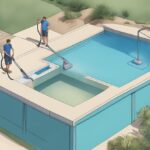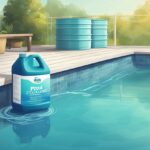Maintaining the correct free chlorine levels in your pool is essential for ensuring that the water is sanitary and safe for swimming. Free chlorine is the active, available form of chlorine that kills bacteria and other pathogens. If the free chlorine level in your pool is too low, it can result in algae growth and the proliferation of harmful microorganisms, which may cause health issues for swimmers. Regular testing is crucial to monitor these levels and ensure your pool remains a clean and enjoyable environment.

When addressing low free chlorine levels, understanding the factors that contribute to this issue can assist in preventing it. Various factors such as exposure to sunlight, high temperatures, a high load of organic contaminants from swimmers, and even incorrect pH levels can deplete free chlorine. Correcting these levels involves selecting the proper chlorine product, accurately calculating the dosage for your pool size, and applying it according to the manufacturer’s recommendations. After treatment, retesting the water is vital to confirm that the free chlorine levels have returned to a safe concentration.
Understanding Chlorine Chemistry
In maintaining a healthy pool, it’s crucial to understand how chlorine works and the impact of stabilising agents such as cyanuric acid. Correctly balancing different types of chlorine ensures safe and clear water.
The Role of Cyanuric Acid
Cyanuric acid (CYA), also known as pool stabiliser, plays a pivotal role in protecting chlorine from ultraviolet (UV) light degradation. When you add CYA to your pool, it acts as a shield, enabling the free chlorine to remain active longer. It’s essential to maintain the CYA level within the recommended range of 30 to 50 parts per million (ppm). If CYA levels drift too high, it can inhibit chlorine’s efficacy, leading to a deceiving scenario where you have sufficient chlorine, yet its sanitising power is compromised. Conversely, too little CYA results in rapid chlorine loss.
Balancing Chlorine Types
In your pool, chlorine exists in multiple forms. Free chlorine (FC) is the sanitising agent actively available to eliminate contaminants. Combined chlorine (CC), mainly chloramines, forms when free chlorine reacts with nitrogen-containing compounds, like sweat and urine. While it still possesses some sanitising capabilities, combined chlorine is less effective and can cause eye irritation and a strong chlorine smell. Total chlorine (TC) is the sum of free chlorine and combined chlorine.
- Free Chlorine (FC): The target for FC is typically 2 to 3 ppm.
- Combined Chlorine (CC): Should be kept as low as possible, ideally below 0.5 ppm.
- Total Chlorine (TC): The sum of FC and CC; TC alone is not indicative of sanitising strength.
To maintain water quality, aim to keep your free chlorine levels at a ratio of 7.5% of the CYA level; this stipulation helps you determine how much chlorine to add. Regularly check your FC and CYA levels to ensure they are in balance, and be aware that the addition of chlorine-based shock can significantly raise your FC levels, necessitating this test post addition.
Adjusting Pool Water Chemistry
Maintaining the right chemical balance in your pool is essential for clean and safe water. Here’s how you can keep your pool’s water chemistry in check, ensuring your free chlorine levels are effective.
Optimising pH and Alkalinity
pH levels in your pool should be between 7.2 and 7.8 for optimal chlorine efficacy. A pH outside this range can reduce chlorine’s sanitising power and cause discomfort to swimmers. Total Alkalinity acts as a buffer for pH and should be maintained between 80 and 120 parts per million (ppm). Use sodium bicarbonate to increase alkalinity and muriatic acid or sodium bisulfate to decrease it.
- Key Ranges:
- pH: 7.2 – 7.8
- Alkalinity: 80 – 120 ppm
Managing Stabiliser Levels
Stabiliser, also known as cyanuric acid, protects chlorine from degradation due to sunlight. However, too much can inhibit chlorine’s ability to sanitise properly. Aim for stabiliser levels between 30 and 50 ppm. If the level is too high, dilute your pool water by partially draining and refilling with fresh water.
- Ideal Stabiliser Range: 30 – 50 ppm
Controlling Bather Load and Debris
High bather load and excess debris increase chlorine demand, causing free chlorine levels to drop as it combats organic contaminants. Regularly skim and vacuum your pool to remove leaves and debris. Encourage swimmers to shower before entering the pool to minimise contaminants such as sweat and body oils. To manage bather load, monitor pool usage and increase chlorine as needed.
- Maintenance Tips:
- Skim and vacuum regularly.
- Promote pre-swim showers.
- Adjust chlorine following high traffic.
By staying on top of these factors, you’ll keep your pool chemistry balanced, ensuring that your free chlorine levels remain effective for a clean and safe swimming environment.
Chlorine Boosting Techniques
To effectively raise free chlorine levels in your pool, you’ll need to use chlorine boosting strategies such as shock treatment and routine supplementation. Correct application will result in a sanitized pool with optimised chlorine levels.
Shock Treatment Strategies
Shock treatment is a powerful method to rapidly increase your pool’s free chlorine level. This process involves adding a large amount of chlorine to your pool water, effectively sanitising the water and preventing algae and bacteria growth.
- When to shock: Perform shock treatment during the evening or at night. This avoids chlorine degradation from the sun’s UV rays.
- Types of shock: Utilise calcium hypochlorite (cal-hypo) for a robust increase in chlorine. It’s ideal when free chlorine needs to rise significantly, say by at least 10 ppm. Alternatively, a non-chlorine shock product can reduce combined chlorine without raising the free chlorine level.
Ensure that you follow the manufacturer’s guidelines on dosage and application. Always retest your free chlorine levels after the treatment to ensure proper sanitisation.
Routine Chlorine Supplementation
For ongoing maintenance, your pool requires routine chlorine supplementation to keep free chlorine levels stable.
- Types of chlorine products:
- Chlorine tablets: Convenient for consistent chlorine release.
- Liquid chlorine: Fast acting, suitable for manual dosing.
- Granular chlorine: Versatile and ideal for spot treatments.
To raise free chlorine, integrate a chlorine product into your pool’s regular maintenance schedule. Apply the product according to the following steps:
- Test your current free chlorine levels.
- Determine the required dose based on your pool size and current chlorine levels.
- Add the chlorine product to your pool according to the package’s instructions.
- Retest to ensure the levels are within the safe and effective range (typically 1-3 ppm for free chlorine).
By consistently monitoring and supplementing with chlorine, you ensure your pool stays clear and clean throughout the swimming season.
Maintaining and Testing Chlorine Levels

Ensuring your pool’s free chlorine remains within the recommended range is crucial for effective sanitation and overall water chemistry. Regular maintenance and precise testing are key to achieving this balance.
Regular Maintenance and Filtration
Your pool’s filtration system plays a significant role in maintaining clean and clear water. Regular maintenance of your pool, including consistent filtration, aids in removing contaminants that can deplete chlorine levels. Ensure that you run your filtration system for at least 8-12 hours per day to keep the water well-circulated and filtered. Check that the filter itself is clean and backwash it if necessary. This will help prevent algae growth and reduce the demand for chlorine.
Accurate Testing and Fine-tuning
To keep your pool’s chlorine levels in check, frequent testing is required. You can use a test kit or test strips to measure the free chlorine in your pool. It’s essential that you perform these tests at least twice a week, or more frequently during heavy use or after a rainstorm.
When using a test kit:
- Fill a small vial with pool water, away from return jets and skimmers.
- Add the indicated reagents according to the manual’s instructions.
- Compare the result with the colour chart to determine the chlorine level.
For test strips:
- Immerse the strip into the pool water for a few seconds.
- Hold the strip level and wait for the indicated time.
- Match the strip to the colour chart to read chlorine levels.
If your free chlorine levels are below the recommended range of 2-3 ppm (parts per million), you will need to adjust these by adding a chlorine product suitable for your pool type. After adjustments, retest to ensure the levels are now correct, and adjust further if necessary. Remember, balanced water chemistry is vital for effective sanitation and the longevity of your pool.











